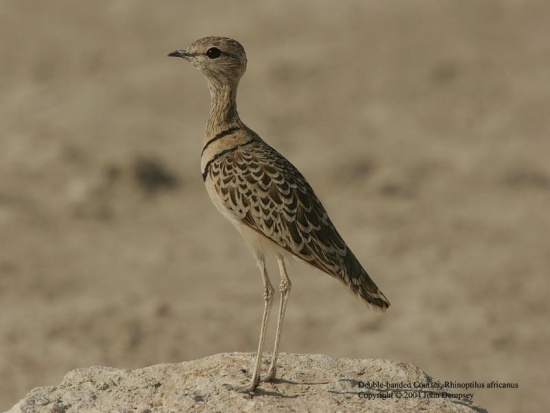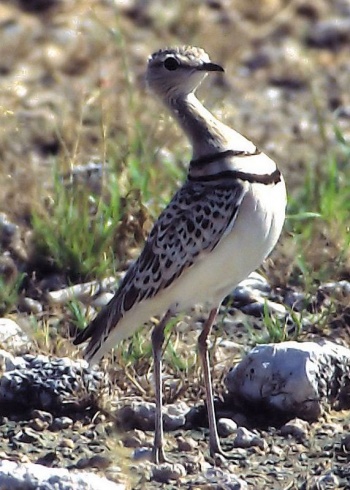m |
m (→Identification) |
||
| (12 intermediate revisions by 7 users not shown) | |||
| Line 1: | Line 1: | ||
| − | + | [[Image:Double-banded_Courser.jpg|thumb|550px|right|Photo by {{user|jdbirdman|jdbirdman}}<br />[[Namibia]], October 2004]] | |
| − | [[Image:Double-banded_Courser.jpg|thumb| | + | '''Alternative name: Two-banded Courser'''<br /> |
| − | + | ;[[:Category:Rhinoptilus|Rhinoptilus]] africanus | |
| − | + | ''Smutsornis africanus'' | |
| + | ''Cursorius africanus'' | ||
==Identification== | ==Identification== | ||
| − | + | Cryptic upland shorebird. Adults have a scaly back and two bands across the breast. Juveniles lack the chest bands [[Three-banded Courser]] is larger, more nocturnal and has a more complex head and chest pattern. | |
| + | |||
| + | ==Distribution== | ||
| + | Arid country of eastern and southern [[Africa]]<br /> | ||
| + | '''Western Africa''': occurs only in [[Angola]]<br /> | ||
| + | '''Eastern Africa''': [[Eritrea]], [[Ethiopia]], [[Djibouti]], [[Somalia]], [[Kenya]], [[Tanzania]] and [[Zambia]]<br /> | ||
| + | ''' Southern Africa''': [[Namibia]], [[Botswana]], [[Zimbabwe]], [[South Africa]] and [[Lesotho]] | ||
| + | ==Taxonomy== | ||
| + | {{Smutsornis vs. Rhinoptilus}} | ||
| + | [[Image:Double-banded Courserdisplay.jpg|thumb|350px|right|Subspecies ''traylori'', displaying<br />Photo by {{user|Vernon+Lundy|Vernon Lundy}}<br />Etosha, [[Namibia]], February 2000]] | ||
| + | ====Subspecies==== | ||
| + | There are 8 subspecies<sup>[[#References|1]]</sup>: | ||
| + | *''R. a. raffertyi'': | ||
| + | :*[[Eritrea]] to [[Ethiopia]] and [[Djibouti]] | ||
| + | *''R. a. hartingi'': | ||
| + | :*South-eastern Ethiopia (Ogaden Depression) and [[Somalia]] | ||
| + | *''R. a. gracilis'': | ||
| + | :*[[Kenya]] and [[Tanzania]] | ||
| + | *''R. a. bisignatus'': | ||
| + | :*South-western [[Angola]] | ||
| + | *''R. a. erlangeri'': | ||
| + | :*Northwestern [[Namibia]] (Etosha region) | ||
| + | *''R. a. traylori'': | ||
| + | :*Northwestern [[Botswana]] (Makgadikgadi system) and western [[Zimbabwe]] | ||
| + | *''R. a. africanus'': | ||
| + | :*Namibia (except northwest), western and southern [[Botswana]], and northwestern [[South Africa]] (northern Northern Cape) | ||
| + | *''R. a. granti'': | ||
| + | :*Western Cape Province and Karoo of [[South Africa]] | ||
| + | ==Habitat== | ||
| + | This is a bird of dry and alkaline flats as well as short grass plains normally up to 1800m. | ||
| + | ==Behaviour== | ||
| + | Although it is active by day it may be nocturnal where temperatures are very high. It is generally seen in pairs. | ||
| + | ====Breeding==== | ||
| + | It nests on the ground among pebbles or animal droppings, laying a single egg. | ||
| + | ==References== | ||
| + | #{{Ref-Clements6thAug21}}#Avibase | ||
| + | {{ref}} | ||
==External Links== | ==External Links== | ||
| − | + | {{GSearch|"Double-banded Courser" {{!}} "Smutsornis africanus" {{!}} "Two-banded Courser" {{!}} "Rhinoptilus africanus" {{!}} "Cursorius africanus"}} | |
| − | [[Category:Birds]] | + | {{GS-checked}}1 |
| + | <br /><br /> | ||
| + | |||
| + | [[Category:Birds]][[Category:Rhinoptilus]] [[Category:Smutsornis]] | ||
Latest revision as of 18:41, 25 September 2023
Alternative name: Two-banded Courser
- Rhinoptilus africanus
Smutsornis africanus Cursorius africanus
Identification
Cryptic upland shorebird. Adults have a scaly back and two bands across the breast. Juveniles lack the chest bands Three-banded Courser is larger, more nocturnal and has a more complex head and chest pattern.
Distribution
Arid country of eastern and southern Africa
Western Africa: occurs only in Angola
Eastern Africa: Eritrea, Ethiopia, Djibouti, Somalia, Kenya, Tanzania and Zambia
Southern Africa: Namibia, Botswana, Zimbabwe, South Africa and Lesotho
Taxonomy
Smutsornis vs. Rhinoptilus
Some authorities (Clements, 2007) place Double-banded Courser in the monotypic genus Smutsornis. However Howard & Moore (2003) and Sibley & Monroe (1996) place it within the genus Rhinoptilus and the Opus awaits clarification.
Subspecies
There are 8 subspecies1:
- R. a. raffertyi:
- R. a. hartingi:
- South-eastern Ethiopia (Ogaden Depression) and Somalia
- R. a. gracilis:
- R. a. bisignatus:
- South-western Angola
- R. a. erlangeri:
- Northwestern Namibia (Etosha region)
- R. a. traylori:
- R. a. africanus:
- Namibia (except northwest), western and southern Botswana, and northwestern South Africa (northern Northern Cape)
- R. a. granti:
- Western Cape Province and Karoo of South Africa
Habitat
This is a bird of dry and alkaline flats as well as short grass plains normally up to 1800m.
Behaviour
Although it is active by day it may be nocturnal where temperatures are very high. It is generally seen in pairs.
Breeding
It nests on the ground among pebbles or animal droppings, laying a single egg.
References
- Clements, J. F., T. S. Schulenberg, M. J. Iliff, S. M. Billerman, T. A. Fredericks, J. A. Gerbracht, D. Lepage, B. L. Sullivan, and C. L. Wood. 2021. The eBird/Clements checklist of Birds of the World: v2021. Downloaded from https://www.birds.cornell.edu/clementschecklist/download/
- Avibase
Recommended Citation
- BirdForum Opus contributors. (2024) Double-banded Courser. In: BirdForum, the forum for wild birds and birding. Retrieved 19 April 2024 from https://www.birdforum.net/opus/Double-banded_Courser
External Links
GSearch checked for 2020 platform.1





